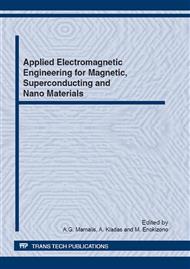p.225
p.231
p.237
p.243
p.249
p.255
p.263
p.269
p.275
Analysis and Experiment of Cylindrical Magnetic Gear
Abstract:
The magnetic gears can transmit torque without contact by applying magnetic force. So in comparison to normal mechanical gears, it may offer a lot of advantages such as low noise, low vibration, wear less, dustless and no lubricant oil at all. Besides, when a very large of input torque entered, magnetic force that pull each other exceeds it limit and the gear spin empty, resulting these magnetic gears limited the torque transmission and can function as torque limiter. However, as disadvantage, it is lack in transmitting torque. In the previous research, we designed cylindrical magnetic gear prototype to increase torque transmission and measured slip torque only. As a torque transmitter, the measurement of driving torque itself is more important. Therefore, the purpose of this research is to measure and study the driving torque due to implication of revolution speed, distance between the magnetic gears and rotational load.
Info:
Periodical:
Pages:
249-254
Citation:
Online since:
June 2012
Price:
Сopyright:
© 2012 Trans Tech Publications Ltd. All Rights Reserved
Share:
Citation:


